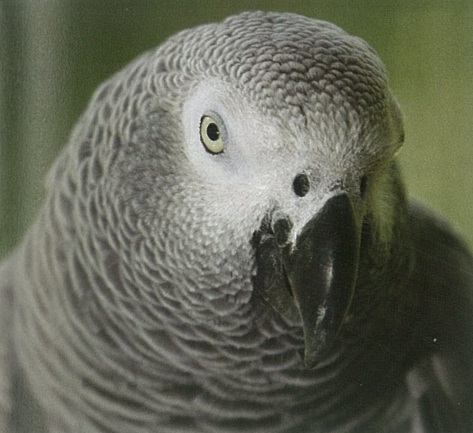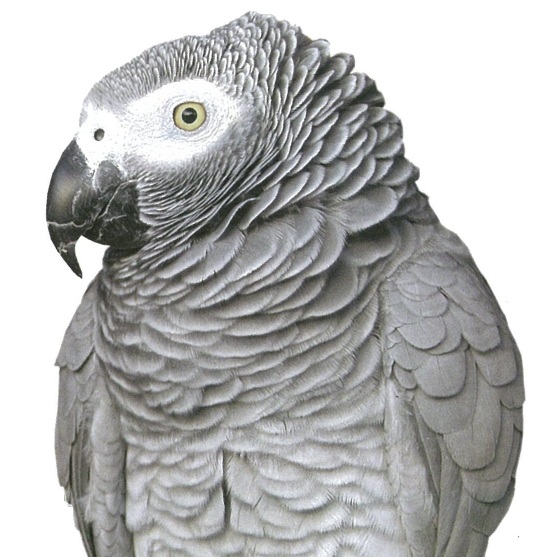A lone grey parrot, lost and out of contact with its flock, is much more vulnerable to being taken by a predator. Living in a flock gives each bird a degree of protection it would not otherwise have as each bird is always on the
lookout for dangers and ready to tell the whole flock of any threat to their safety. But the pair bond between adult breeding birds is also very strong. In addition to the loud screeches and screams used to communicate over some
distances to flock members, the birds also have a repertoire of much softer calls which they use to communicate with their partner or, as young birds, with their siblings. They also have a system of raising certain feathers, particularly facial feathers as part of their 'body language'. Birds can tell if each appears alert, or relaxed, or frightened, or playful. Greys often ask their mate to preen their head. Here, one bird raises its head feathers and keeps its eyes sunken in or half-closed as it offers its head to be preened. Such mutual preening certainly strengthens the pair bond between adult birds, but it is also seen being done between siblings. Usually,
after one bird has preened the other for a few seconds, they swap roles and so each bird gets preened.
lookout for dangers and ready to tell the whole flock of any threat to their safety. But the pair bond between adult breeding birds is also very strong. In addition to the loud screeches and screams used to communicate over some
distances to flock members, the birds also have a repertoire of much softer calls which they use to communicate with their partner or, as young birds, with their siblings. They also have a system of raising certain feathers, particularly facial feathers as part of their 'body language'. Birds can tell if each appears alert, or relaxed, or frightened, or playful. Greys often ask their mate to preen their head. Here, one bird raises its head feathers and keeps its eyes sunken in or half-closed as it offers its head to be preened. Such mutual preening certainly strengthens the pair bond between adult birds, but it is also seen being done between siblings. Usually,
after one bird has preened the other for a few seconds, they swap roles and so each bird gets preened.
Minimal aggression
While aggressive encounters tend to be rare, birds will give plenty of warning before actually fighting. When giving a warning a grey will fluff up most of its body feathers and make a sharp mechanical 'clicking' sound once or twice as it snaps its lower bill against the upper bill. Like most parrots, greys have voluntary control of their iris/pupil and a display of aggression often includes contracting their iris or 'pinning' their eyes as it is also called. Generally at this stage one bird will back down readily to avoid further conflict.Parrots under pressure
The daily life of grey parrots is certainly a busy one. Most of the time the birds 'live on their nerves' and are very cautious in their behaviours. As their forest habitat is now being reduced through logging for the timber trade, they are under more pressure to find alternative sources of food and this can include agricultural crops. Due to these feeding habits, some birds are seen as 'pests' in agricultural areas on the edges of the forest.
This grey asks his mate, a Timneh, for a head scratch; note the sunken, relaxed eye and
the way in which the bird on the right presents his head and neck to be preened.
the way in which the bird on the right presents his head and neck to be preened.

This grey is alert and attentive.
The raised feathers around the cheeks
show that the bird is in a relaxed mood.
The raised feathers around the cheeks
show that the bird is in a relaxed mood.

The bird is 'pinning' his eyes:
this is a clear sign that he is
very excited about something.
this is a clear sign that he is
very excited about something.

A very relaxed grey. The head feathers form
a little 'ruff' around the back of the head
and the cheek feathers are raised.
a little 'ruff' around the back of the head
and the cheek feathers are raised.